#norwegian film institute
Explore tagged Tumblr posts
Note
Hello, I've been paying attention to Dustborn and the only actual question I would like to make is if you see anything worth dissecting on the fact that it got tax money from the EU? Games funded by a government are very rare, so I wonder if analyzing the game from that perspective provides something interesting into game development.
Getting tax breaks and incentives from various governments is actually very common. Government investment is often a lot like scholarships to university - they have bundles of money set aside for applicants that meet certain criteria. Most governments are interested in encouraging economic activity within their borders, especially tech industry growth. Tech pays pretty well, isn't large on space, and encourages secondary growth - tech workers that move to the area will buy usually houses and spend with local businesses, leading to a positive cycle of improved economic growth for the area.

As an example of this, in 2020 the Department of Community & Economic Development of Pennsylvania offered a [tax credit] of 25% of qualified expenses for the first four years of development and 10% for each subsequent year back in 2020 to game developers who spent at least 60% of their total production costs in Pennsylvania. The politicians were hoping to encourage game developers to move to Pennsylvania and they were offering tax credits as incentive.

Similarly, the Norwegian Film Institute offers funding to [audiovisual productions that meet their criteria]:
The screenplay, or the literary work on which the screenplay is based, has originally been written in the Norwegian or Sami language
The main theme is connected to Norwegian history, culture or social conditions
The action takes place in Norway, in another EEA country (countries of the European Union [EU] plus Iceland, Liechtenstein)
The work contains significant contributions from rights holders or artists resident in Norway or in another EEA country.
Dustborn ticked enough of these boxes that the NFI agreed to fund them. It wasn't a special thing, it was government money set aside to encourage the development of Norwegian-focused cultural audio visual works. That includes video games, movies, television, or any other kind of audio visual production. Lots of smaller works, games included, find funding through programs and grants like this.
[Join us on Discord] and/or [Support us on Patreon]
Got a burning question you want answered?
Short questions: Ask a Game Dev on Twitter
Long questions: Ask a Game Dev on Tumblr
Frequent Questions: The FAQ
28 notes
·
View notes
Text
Jacegan Week 2024: Day Six. Historical

1910-1920s silent cinema AU
TW: period-typical racism and homophobia, “Birth of the nation’s” cinema success, implied radium poisoning, mentioned Red Scare
In this au, Jace and his brothers(and a little sister Visenya) actually grew up in the whole-acting family. Their mother, whose family got poor after losing all of their money during the Long depression, started her vaudeville acting career and became the family's breadwinner from the tender age of eight and rose up to the second highest paying actress(after Lotta Crabtree). Their father is a famous musician coming from a wealthy family, their paternal grandmother is a former actress by herself and their aunt is the costume maker for the theaters. They are not really in touch with their maternal side of the family, since they did not approve of their mother's acting career.
Meanwhile, Cregan comes from the farmer’s family of Norwegian second-geheration immigrabts. His family went bankrupt in the panic of 1907, so he and his sister were left with almost no money. Cregan was forced to turn to seasonal worker, while Sara started to work at the clock fabric.
Cregan met Arra Norrey at the mill at Lawrence. They married and later had a baby Rickon together. However, since Arra was forced to work even when she was ill and pregnant, she died of influenza not so long after Rickon’s birth. It happened not so long before the Lawrence strike of 1912, where Cregan actually took a huge part: from helping to evacuate the kids to standing up against the strikebreakers.
Cregan and Arra actually loved to go to cinema to watch movies(and Arra especially loved Max Linder’s and Roscoe Arbuckle’s comedies), but after the strike is won, Cregan feels some type of rage against the cinema that it does not depict the life in its full nightmare and even the social films mostly concentrate on such things as imprisonment and abortion(he understands it’s significant though) and the films about the labor focus more on the redemptions of masters which is not the part of workers ordinary lives. He decides that no matter what, he will wear his IWW red card proudly.
He is lucky though and after the long season of season work he, with Sara’s help he gets a clerk job at one of the “ Radium Luminous Material Corporation” offices in New York. In his spare time, he writes scenarios for different studios and walks a lot with Rickon.
Meanwhile, Jacaerys is living his best life: he lives with his mother, father, four brothers, cousins and little sister, they all star in the feature films at their director-grandfather’s studio with his family, and now is set to marry his cousin Baela, who is an actress too(since it is a pre-Code times, she legally still can play any role). Her sister Rhaena, meanwhile, helps her mom as costumer.
Meanwhile, Corlys gets the news about his rivals in a Biograph(corporate spies, you know) that D.W.Griffith has left them, founded his own company and now is adapting “The Clansman” by Dixon. No need to say both he and Rhaenys are infuriated by it. They decide to start to make a counter-move and make another period drama movie to beat it(they’ll fall in beating in the box-office, but a good movie will be made).
Sadly, they did not find a good scenario for a long time. Come the winter of 1914, and only there they found the scenario written by Cregan: which tells the early life of Samuel Gridley Howe, the famous abolitionist, friend of John Brown and the founder of the Perkins’s Institute for the disabled. More precisely, it tells about his participation in the Greek Revolution and arrest in Poland.
They buy the scenario from Cregan, and Corlys, seeing that this young man has the potential of a good scenarist, gives him a two-year contract. Cregan agrees and starts to refine the scenario alongside Rhaenys.
Both young men meet each other at the stairs, when Jace and Baela accidentally stumble on Cregan, who is going out of Rhaenys’s room with a lot of paper in his arms, cause Rhaenys has a tendency to write every scene in detail.
They cross their ways simultaneously. They see each other on the set, when Cregan sometimes approaches cameraman Elmo Tully while Jace and his screen partner are waiting for them — the partner is an actor who played young Greek Howe meets in his travels. Daemon, who is playing the older lead, does not even attempt to hide total disinterest.
They cross their path at the costume shop, when Jace sees his cousin Rhaena disciss costumes with Cregan, and his voice with norwegian accent strikes something in him does not understands.
They cross the way during the lunch break, when Jace with his stuntman and younger brother Luke are discussing something funny, and Cregan suddenly thinks how it may look like on the screen and attempts not to listen to them, but to read on their lips, but it fails miserably, since he stares on someone else’s faith without even noticing.
Their first conversation happens when Cregan sees Jace dragging ten books about Howe Rhaenys asked about and another five illustrated books about clothes of this time for Rhaena. They talk a lot about their favorite books and Cregan mentioned he would love to read «Martin Iden» by Jack London, but he does not have a strength to go to the library after the whole work day and spending time with his son. Jace is surprised by learning that their new scenarist has the son and urges him to bring the boy to the work.
Next day Cregan finds the book he asked nearby the set.
Baby Rickon absolutely loves the studio, especially playing hide-and-seek with kid Aegon, Viserys and Visenya. Sometimes, Luke and Rhaena playfully join them. Even lesser times, Laena coo over new boy and secretly give them a lot of sweets to both Cregan and Rhaenyra’s chargrin.
During the filming and writing there are not so many incindents that may cause anybody harm. However, one day the decoration falls on the set, when Luke is making the stunts, and it takes both Jace's and Cregan's fast reactions to drag him from the dangerous zone. After this, they merely look at each other and start to laugh — to everybody's confusement.
At this moment, they are just happy men, and oh gods, they are sure that the film they are making will be great.
(It would not be great, but good nontheless. Like many films they will do after it, but this time will be remmebered as the happiest one).
(Neither Jace, nor Cregan doesn't know know, where we'll ther relationship go, and how many moments, both good and bad, they will share together. There would be a twelve movies(most of them a hystoricals, one based on personal tragedy and one of them a mix of socialist propaganda and action), temporarily break-up, not really happy marriages to women(similiar to their partners, but not actually them), arrests during the Red Scare, Luke's injury and his marriage to Rhaena, adaptation of «Martin Iden» they made together, Cregan's sister being Radium Girl, scandal based on rumours overblown by Hedda Hopper, serving as historical consultants, the world travel, La Olimpiada Popular and death — one at Madrid, and another at Jarama. So many things).
But now, at this moment, they are happy.
#au#cregan stark#hotd#house of the dragon#jacaerys velaryon#jace x cregan#jacegan#jacegan week 2024#fire and blood
15 notes
·
View notes
Text
Rykter cast featured in Bergens Tidende while filming season 3
translated below :)
New rumors are spreading: “Getting in the mood very quickly.”
The TV success from Bergen continues: “We had to think differently”.
The TV series from Bergen is finally starting again.
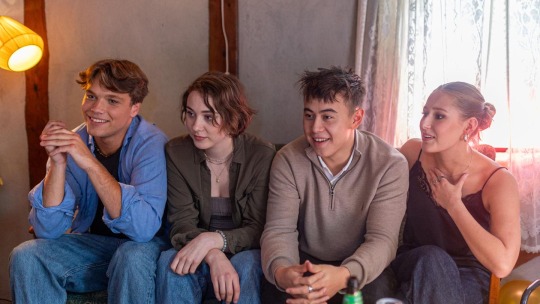
Teo Tomczuk, Sisilja Garen, Martin Storebø Koh, and Alisah Süssmann also have central roles in the next season of \"Rykter\". Shown here on the sofa during a morning party in Telavåg.
By: Frank Johnson
Alice Bratshaug (photography)
Published: September 19, 2023
It is Friday morning in Telavåg. The seaside house at the water's edge is full of festive young people from 16 to 17 years old. The alcohol is on the table, the guys and girls are dancing, the atmosphere is both amorous and aggressive. Many adults are standing around, watching and filming.
Sexual identity
Suddenly, a fair haired man stands up, shouts “cut” - and everything calms down. Before the music is turned up.
“It's a bit weird to dance in the morning without music. But the crew is also moving, so we get into the mood very quickly”, says Teo Tomczuk (17) smiling when the camera is switched off.
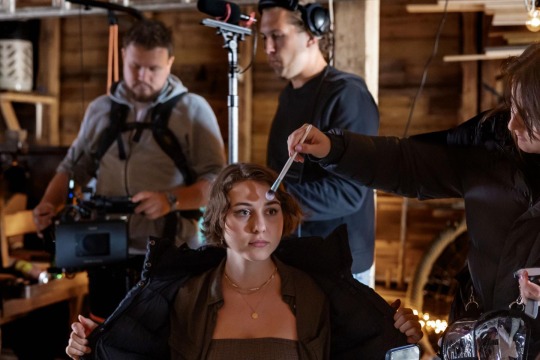
Sisilja Garen has makeup done for new party scenes.
“The adolescents in the scene are going to be at a party, so we play music between takes. Then they're on it right away”, adds director Andreas Milde.
The Bergen company “Mothership” is finally starting to film new seasons of the teen series "Rykter" for NRK. Most recently, students in tiende klasse (final year of lower secondary school) were followed on fictitious Vesterøy. Now the main characters have started videregående skole (upper secondary school).
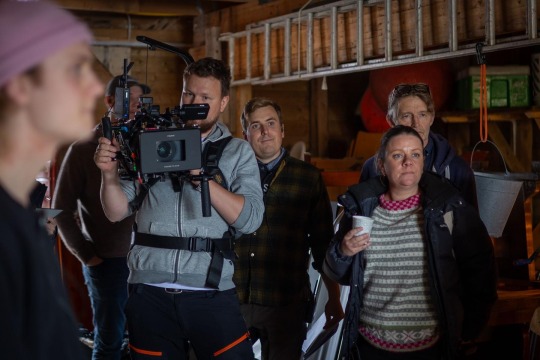
Photographer Christer Steffensen and part of the crew in filming for "Rykter".
Things that were hinted at in the last episode – drug problems, identity, taking responsibility – are all made clear.
“They have reached a new phase in their lives and will, among other things, explore sexual identity”, says photographer Christer Steffensen, who will also direct ten of the episodes.
Success in Italy
In addition, 30 ten-minute episodes will be recorded this time. These will be released in two parts on Norway’s national channel, probably in the first few months of 2024 (liars). The series creator is, the same as last time, Christoffer Ebbesen.

Producer Linda Bolstad Strønen is keeping up with the recordings in Telavåg.
The budget is 22 million NOK. Producer Linda Bolstad Strønen admits that it has been tough to get funding after NRK, like most other channels, has reduced its budget. Despite the fact that each episode is seen by 200,000 in Norway alone.
Therefore, among other things, they had to go to the broadcaster Norddeutscher Rundfunk (NDR) in northern Germany. Production money from the West Norwegian Film Center and the Norwegian Film Institute, as well as support from the Media Fund Zefyr in Bergen, has also helped secure a new season.
“We had to think of an alternative, so it is a patchwork of contributors. The fact that "Rykter" was also picked up by the public broadcaster RAI in Italy, with great success, gives us good momentum”, says Bolstad.
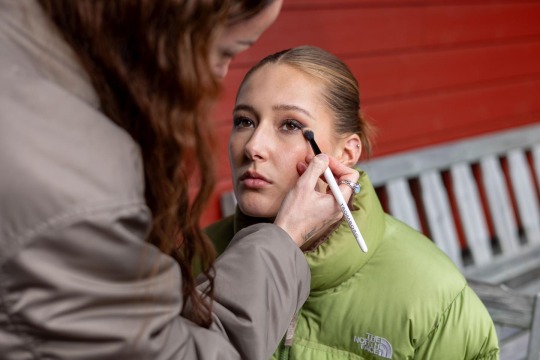
Alisah Süssmann from Fana goes to the dance department at Langhaugen upper secondary school.
The Nordic countries have aired the series. Now Mothership is betting even stronger internationally.
“It is a clear advantage that we have a finished season to show off.”
We are a "Rykter" (rumors) gang
Glesvær and Telavåg became important recording locations. This time Sund secondary school is the new base.
“The collaboration we have with the school there is incredibly important. They really show up”, says Bolstad.
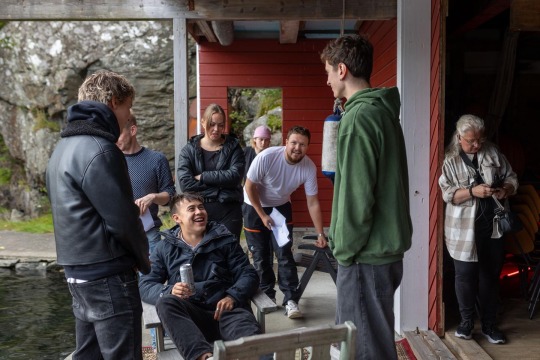
The atmosphere is good between recordings at the seaside house.
Many of the main actors are students themselves, so there has been a lot of planning with parents and schools to get the schedule in place.
“Last year we shot 30 episodes in one go. Now we record ten at a time and have a two-week break until the next few. It gives everyone some breathing room”, says Bolstad.
It has been a whole year since the actors last stood in front of the camera. The party scene comes along in episode six. Now there will be recording until the middle of January.
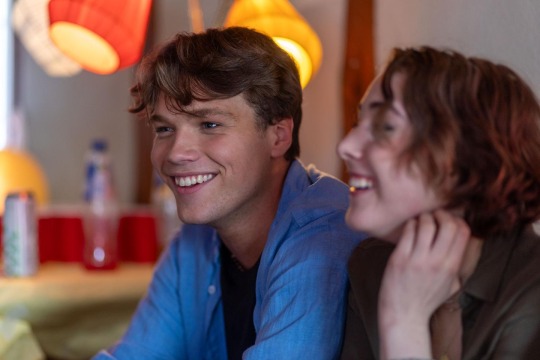
Teo Tomczuk grew up in Solund municipality in Ytre Sogn, while Sisilja Garen comes from Øystese.
“I have missed the gang very much, both in front of and behind the camera”, admits Tomczuk, who plays Mathias.
“We are a "Rykter (rumors) gang" who both know each other well and try to keep in touch, but we live spread out. It's not often that everyone gets to meet up”, says Alisah Süssmann, Sara in the series.
We bring ourselves into the roles
They are happy that another season came. It gives them the opportunity to go deeper into the roles and explore new issues.
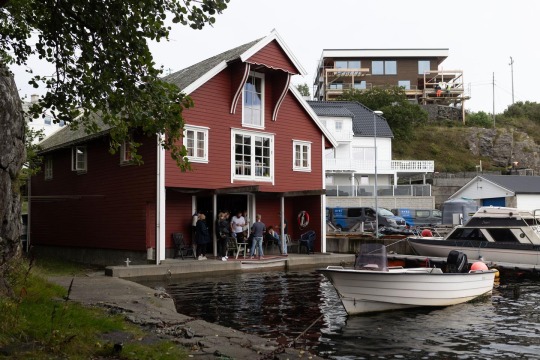
The seaside house they use for filming is close to other buildings.
“I was a bit afraid that I wouldn't fully get into my character, Thea, but everything came back as soon as I got on set. The production crew wants it to be authentic, so we bring ourselves into the roles. We know the characters best”, says Sisilja Garen.
“From day one, I have heard from a friend of mine: "You are exactly like yourself. What you're doing is not acting". One day the director said we should screw with the script and just do what we wanted”, says Martin Storebø Koh, who plays Felix, and laughs.

Martin Storebø Koh from Austevoll gets an even bigger role in the next season of “Rykter”.
“We have had a little part in the script’s process, and have adjusted when needed to make it even more believable”, adds Süssmann.
Followed home by young girls
And since the TV series has become a success, they are also becoming well-known again.
"I am followed home by young girls every day, they stand outside the door until my mother chases them away”, says Tomczuk and laughs. He also talks about emails from Italian fans.
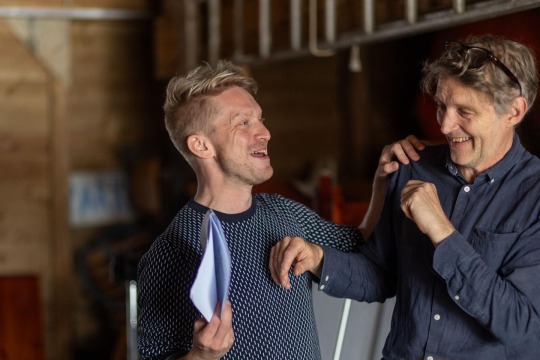
Director Andreas Milde and lighting master Poul Iversen during a break.
“I happened to be in Italy and got a login to RAI. It was very strange to see yourself dubbed. They kept my laugh, but used a different voice for me”, says Süssmann.
Director of the first episodes, Andreas Milde, thinks the target audience is getting older this season.
“Since the main characters in the series are getting older, the audience will probably be older as well. But we know that 13-14-year-olds like best to watch somewhat adult series.”
_
(y'all this is literally the last promotional thing i had saved to translate... NRK why are you not hyping people up about this show?!? 🤨)
#rykter#rykter nrk#rykter spoilers#rykter cast#nrk rykter#teo tomczuk#sisilja garden#martin storebø koh#alisah süssmann#rykter season 3
14 notes
·
View notes
Text
The police withheld communication with the Princess around the wedding in Geiranger
The police probably broke the law several times when they failed to publish several critical e-mails from Märtha Louise's management.
Princess Märtha Louise and Durek Verrett's management sent several harsh emails to the police in Møre and Romsdal this summer about the wedding in Geiranger.
Yesterday, it became known that they blamed the police for allowing media to film from the air.
Now, it turns out that the e-mails went like ping-pong balls between the management and the police for several weeks before the argument was put to rest. Only this week did the police decide to publish them in the postal journal, as they are obliged to do.
This means that the police have kept a number of documents about the wedding secret for a long time.
- It is deeply regrettable to see that the police do not have greater respect for the principle of openness than this suggests, says General Secretary Reidun Kjelling Nybø of the Norwegian Editors' Association.
She says it is very important for journalists that the police also follow the law and keep a record of all letters and e-mails on an ongoing basis.
Several documents disappeared
The e-mails about the controversial drone filming over Geiranger are not the only documents that never appeared in the police records - until now:
Several e-mails dated April following a meeting between the police, the World Heritage Center and the wedding hotel appeared in the postal journal this week.
The same applies to e-mails from the end of May from the police to the princess's management, with dialogue around a press release that was to be sent out.
Also, e-mails from the mayor of Stranda to the police on 23 May only became visible this week.
This is what the police should have done
The police must keep continuous postal records of all incoming and outgoing mail. This applies to all public institutions and is laid down in the Public Officials Act, the Archives Act, and the Archives Regulations. This should enable most people—and the press—to follow what is happening.
The civil ombudsman has stated several times that record-keeping must be done continuously and as quickly as possible:
"The ombudsman finds reason to point out that the department must organise its work in such a way that record-keeping takes place continuously and as quickly as practically possible, also during periods of high work pressure or delays in a case. Gradual record-keeping, and especially record-keeping that is postponed until after the case has ended or until the case is less relevant could lead to the perception that the rules on transparency [are being] disregarded."
- Haven't tried to keep anything secret
All summer, the police have published postal records, but they have not attached the e-mails about the wedding. Department director Iselin Nevstad Øvrelid in Møre and Romsdal police district blames, among other things, high work pressure.
- The police have not tried to keep anything secret. We are dependent on talking to others in the organization to take care of preparedness, confidentiality and safety. It's not that we don't want to publish it, but we have to be confident that what we publish is correct, she says.
- But they don't need two months for that, do they?
- We had to use the time it took so that we could be sure that everything was taken care of. But we should certainly have recorded it earlier, she says.
The police recently received criticism from the bride and groom's management for revealing that the wedding was to take place outside, close to the hotel.
- Clear violation of the law
Lawyer Kristine Foss in the Press Association states that the police's handling of the e-mails about the wedding breaks the law.
- The police are breaking the law because they are withholding the e-mails for such a long time. It violates the entire purpose of the legislation, Foss asserts.
- But the police point to high work pressure and the need to clarify questions about, among other things, the duty of confidentiality and safety. Isn't that a point?
- Such conditions can mean that it can take a few extra days, but it shouldn't take several months, she says.
She underlines that the whole point of keeping records is that people should be able to continuously monitor what official establishments are doing.
Will attempt to change practice
Department director Iselin Nevstad Øvrelid firmly denies that the police have received instructions from Märtha Louise's management to play tricks with the postal record. As far as she knows, all relevant documents should now be on the table.
- We should have recorded this earlier, and we just have to take that with us. We shall strive to ensure that it is done as the Public Officials Act and the Archive Regulations say.
General Secretary Reidun Kjelling Nybø of the Press Association believes it's the only thing missing.
- They should of course keep records in the postal record continuously, that is what they are obliged to do according to the legislation.
Translation and editing for clarity by me of an article by Synnøve Hole for NRK, published on Aug. 23, 2024, at 19:23.
#norwegian royal family#royal reporting#norway politics#princess märtha louise#shaman durek#royal wedding#nrk#240823
4 notes
·
View notes
Text
WIP Wednesday: Le Fin Du Monde
A bit of a shorter one this time around, that post-Christmas lethargy has hit me like a bag full of hammers. Anyway, I've noticed I don't really deal with memorable locations much in my writing. It isn't so much that I avoid them as much as my style not really including a lot of description of external stuff. Oh, if you want to know every nook and crevice of the protagonist's soul, I can help you there, but where are they doing their soul-searching? I don't know. A café perhaps?
Well, today I'm going to talk a bit about a location from His Impossible Brushstrokes that buck the trend, in that I feel I have a fairly complete picture of how the place looks and feels. This is Le Fin Du Monde, a café in San Francisco that sells alcohol or a bar with a barista that opens uncommonly early. It's one of those perspective trick puzzles, duck-or-rabbit pictures, but for serving of drinks.
Monde as the place is most frequently called by people too cool to say the whole thing, which is to say most of its customers, is Oscar and Mara's preferred coffee spot. Oscar likes to think he's above day-drinking at the establishment as pregaming for a wild night, but he is lying to the world and himself, and not for the first time either.
As one might expect from an establishment with a foreign name, Monde is tooled towards the art crowd, the black-painted walls and felt sofas and chairs in muted colors seem to be hand-picked to be the kind of dour that'll get an artist thinking along the lines of art or mania. Oscar for his money considers the whole place to be a den of the pretentious and the wannabe, but he hasn't found another place that has unlimited refills and a sufficiently dank interior yet, and so he keeps going to Monde.
Now, keen-eyed readers might remember me writing about the John Carpenter Masters Of Horror episode Cigarette Burns as a source of inspiration. I chose to name this café after the cursed art film the protagonist seeks after in the movie, although I did feel compelled to shorten it a bit. La Absolue Fin Du Monde did feel a bit long for the name of a café, even if a shortened version was available.
As for real-world inspiration, Monde is a bit of a tribute to my former favorite cafe, a nameless thing on the first floor of the Norwegian Film Institute. Back in my film school days, I used to spend many an afternoon there with my friends as we drank ourselves silly on black coffee with free refills, discussing some film project or other that we'd never get around to actually making, or writing screenplays or other coursework with the measured panic of the habitual student. The place is shut down now because apparently, it's a crime to host nice cafés in downtown Oslo, but it will forever live on in my memory, as well as on the pages of Brushstrokes. I've made the fictional place a bit cooler, I will admit, but all is fair in love and war fiction.
#writing#WIP wednesday#his impossible brushstrokes#in which Peebs gets maudling#seriously though two of my favorite cafés in Oslo got shut down within a year and a half of each other#the gentrification!#Where's an honest bohemian supposed to get their writing done huh?
9 notes
·
View notes
Text
BIG NEWS: The next leg of development is officially funded!

Thanks to the Norwegian Film Institute, we’re able to pick up active development on our fishing game again! This article is in Norwegian
We found out a couple of days ago, but it still hasn’t quite sunk in. This is a project milestone we’ve been attempting to reach for years, after all!
For this leg of development we have big things in store >:3 if you’re interested in live updates on that end, or otherwise want to support our queer little fishing game featuring a transmasc main character, i highly recommend you join our discord server! We do playtests, share art and stuff in there!
#untitled fishing game#fishing game#fishing#action rpg#platformer#indiedev#indie game#queer#transmasc#gay gaymes for gaymers
16 notes
·
View notes
Note
Hi! I'm a fairly new follower of yours and also swedish 👋 I saw that you mentioned xenophobia against Finland and I realised that I've never heard of it before which made me a bit worried tbh. Ignorance and all that 🙃 Would you mind elaborating a bit or maybe pointing me in the right direction for where I can read up on it?
hey, i mean first of all there’s the fact that scandinavian people tend to get so very offended whenever someone accidentally includes finland in the precious precious exclusive club of scandinavia... like people can get downright hostile about it and i think it’s quite clear that it stems from a deeply engrained xenophobia that has a very long history that i am not quite equipped to delve into in detail and i don’t have time to find citations but this is like... pretty basic stuff you can easily google your way to. anyways, not only did sweden rule finland to different extents between the 13th and 19th centuries, but this history also includes the long cultural imperialism and forced assimilation of finnish-speaking populations in at least sweden and norway to the point that many of the ethnic finnish populations in these countries have become completely removed from their language and the finnish culture. there is also the fact that when the swedes invented state eugenics finns were one of the main targeted populations for investigation and deemed as inferior to the germanic swedish population (along with the sámi of course, romani populations and others). finnish was also banned in places like schools for a long time, until the mid 20th century, and children who spoke it (or meänkieli, which is technically a separate language but which linguistically derived from finnish and is spoken in tornedalen by an ethnically finnish population) would often be ruthlessly punished for it (a similar history exists with the kvens in norway as far as i know, but i am not super knowledgeable on that), and this directly stems from the eugenic idea of finnish people as racially and intellectually inferior to other nordic populations, aka the swedes, norwegians and danes (icelandic people i think are a bit of a different story, and i am not at all as familiar with the history between iceland and the rest of the nordics so i shall not speak on it) largely because of their ethnic origin (baltic/finnic as opposed to germanic) and their perceived “easternness” (i believe they were historically derogatorily referrred to as “China Swedes” in America) which is pretty obvious when one considers stereotypes about finnish people (primarily men) as alcoholics, violent etc. that persist to this day at least in sweden (i used to hear them constantly living farther north where there was a closer proximity to finland and also to communities of ethnic finnish people). Finnish speaking populations in sweden do have minority language privilege today, like for example the sámi, but that privilege honestly does very very little other than give access to some public services in their native language, despite the huge amount of ethnic finnish people living in the country.
edit: there’s a film called elina, som om jag inte fanns which deals with the erasure of the finnish language in sweden which if you can get your hands on it it’s not a bad watch. it’s directed by klaus härö who is a swedish-speaking finnish director and who also made a film called den nya människan about life at a eugenic women’s institution (i have seen it referred to as a swedish girl, interrupted but i shan’t comment on that...) and mother of mine (i can’t rmr the swedish or finnish title rn) about a finnish boy sent to sweden during wwII as many finnish children were, as well as a few other films. he’s not a groundbreaking filmmaker by any stylistic means or anything, but i think he tells these stories that not many people have wanted to touch upon in the nordic popular culture so i like to plug his shit.
#if i had time to source this i’d make it rebloggable but i don’t want people to just take my word for things#asks#anon
18 notes
·
View notes
Note
Still on the subject of missing films, how many Buster movies are missing? Entirely or pieces
The only films missing of his silents is with Arbuckle, A Country Hero. He does have a few foreign talkies that are missing like, Buster se marie (French Parlor, Bedroom and Bath) De frente, marchen (Spanish Doughboys) and Le plombier amoureux (French Passionate Plumber (which imdb makes it very confusing))
So.. I don't exactly know *everything* when it comes to what ones are missing scenes, or what scenes are missing. I read conflicting things often. One person will say a film is completed while someone else argues that it is missing frames. I don't think there's a for sure answer just because we can only really assume. I don't get too involved in this, I just know some things. But I did look up some information -
The Cook - Found in an unmarked canister at the Norwegian Film Institute in 1998, alongside A Reckless Romeo. A second print, containing more footage, was found in 2002, and the two were combined to create a restored version. However, some scenes are still missing.
The Cameraman - So apparently there is a scene missing that was said to be damaged, in an old release of the film you can see a whole 20 seconds of it (it's really...exciting..) you can find that clip here. The current release of the movie does not have these 20 seconds included. There's more information about the location and missing scene here. then I found this bit of information on the missing scene and an interview with Buster about it:
FIAF archives and private collections around the world were combed to find the 291 feet of missing footage, unfortunately without success. In a lengthy 1958 interview with Keaton, George Eastman House’s influential curator George Charles Pratt tells Buster: “There’s one unfortunate gap in our print. Apparently the negative has deteriorated. It’s the part where you go out the first day and everything goes wrong. There’s just a bit of that left…” and Keaton replies: “That’s a shame because some of the biggest gags are there”. Fortunately, only 30 shots are missing from reel 3, described as follows in the original MGM script continuity: EXT Hotel: Buster sets up his camera in front of Hotel. Doorman exits Hotel, followed by Admiral and his staff and get into car. Buster takes pictures of the doorman, Buster walks away, then realizes he should be photographing the Admiral. MS Yacht in dry dock, people in foreground. Girl standing by bow of boat with a bottle in hand to christen boat. Buster sets up his camera to capture image. The boat slides into water Buster and camera are on a plank tied to the boat and slide into water along with the boat (fade out). CU of cannon firing, Buster photographs (fade out). MS: MGM News Reel office: Buster enters carrying camera, shows a can of film to girl at desk, editor greets Buster who gives him reel of film and says (intertitle) “It’s great stuff, Sir! I hope you’ll look at it”. Office door opens and hits Buster, door closes as another cameraman comes through the door, breaking glass with his tripod. LS Projection Room: Editor is talking with girl, Buster walks to foreground and sits in front row of the screening room. Shot of Editor looking mad and girl looking disappointed. MS of men on horses in a jumping meet. Buster had cranked camera backward, so horses are jumping in reverse. MCS of Buster in screening room looking very sad. According to the archival records, the negative was shipped from MGM Culver City to Kodak on February 1951: upon inspection of the negative, Kodak notified George Eastman House and MGM of the missing footage from reel 3. There are no records confirming when the original camera negative was destroyed, and it is thought that it might have been in the 1965 MGM vault fire. (source its a little further down the page, you can read the whole thing to learn a bit more from others that posted.)
Here are more sources(because honestly there's way too much to put in here)
Cohen Restoration Project - This is from 2018-2023 talking about the films that had restoration done, what had been restored and missing frames ect. (and kind of how they take multiple versions of a film and put them together) And kind of found this on my search - more information as to *why* some films ended up with missing frames or are now lost - here & here
Hope this helped. idk its a bit convoluted...
Anyone that has better knowledge or if I have made any errors, please chime in. Thanks!
#ask#I shouldn't respond so late at night#I almost put Coney Island was missing smh#and idk whats going on with Le plombier amoureux#the cast on imdb is weird and theres no wiki
3 notes
·
View notes
Text

Fortitude (2015) Episode #1.1
Summer has arrived in the remote Norwegian Arctic town of Fortitude. It's a happy time for the locals who bask in the hours of daylight. The town, with a population of 713 residents, has no crime and is home to the Arctic Research Centre. The biggest danger is the presence of polar bears requiring anyone going out of town to carry a rifle for their own safety. The local Governor, Hildur Odegard, has plans to open a hotel carved into the local glacier but these are put in doubt when two guys discover the remains of what appears to be a mastodon and Professor Charlie Stoddart from the Institute may no longer give the green light to proceed. When Stoddart is found butchered in his house, it is initially thought to be a bear attack but it quickly becomes clear that it's a case of murder. Local resident Henry Tyson, who is dying of liver cancer, is now convinced that a death three months earlier, also reported as a bear attack, was murder and points the finger at Hildur and police Supt. Dan Anderson. When a senior detective from the London Met arrives to assist with the investigation, Anderson makes it clear he is not welcome.
Although set in the Norwegian Arctic, this show was filmed in Eastern Iceland.
#Fortitude#tv series#tv show#Norwegian arctic#crimes#finding#mastodon#glacier#polar bears#DCI Morton#S1E1#drama#horror#mystery#crime#snow#like it!#just watched
2 notes
·
View notes
Text
Gunhild Fights for Female War Heroes on Screen – Faces Support Hurdles
Director Gunhild Westhagen Magnor is on a mission to bring a female war hero to the big screen, a pursuit she says is being slowed down by the Norwegian Film Institute (NFI) due to limited funding. With recent attention on war films dominated by male heroes, Magnor’s work highlights the underrepresented stories of women who played critical roles during WWII. Magnor has dedicated a decade to…
0 notes
Text
youtube
The Norwegian Film Institute Dodging DUSTBORN Questions!
0 notes
Text
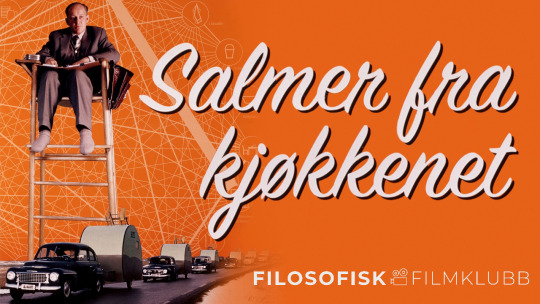
Traditions in transition: cinematic perspectives on the modernization of post-war societies (2/4)
The following article is the second in a four-part series looking at how cinema depicts post-war societies’ transformations, and more precisely the transition from a traditional society to a modern one. You can read each article separately, so there’s no need to worry if you haven’t read the previous one yet. Just know that if you are eager for more, you can find it HERE.
In order to examine our topic from all angles, every article of this series will be dedicated to a separate movie, each originating from a different country. Since context is essential to better understand what lies beneath images, and thus propose an in-depth analysis, I will always start by introducing the director and the significant historical events surrounding the films’releases.

Kitchen Stories, Bent Hamer (2003)
This new installment aims to study how social and environmental impacts of the Norwegian post-war industrial boom are depicted by Bent Hamer in his long feature Kitchen Stories (2003).
Part 2. Kitchen Stories (Salmer fra Kjøkkenet, Bent Hamer, 2003)
For a long time, nordic countries’ economies relied on cultivation, livestock farming, forestry operations and fishing. In fact, the mechanization of agriculture and manufacturing did not begin until the end of World War II. Therefore, although technological advancements and mass production boosted productivity, they simultaneously standardized productions, environments, and social behaviors. It should be noted that some nordic countries were more affected by the industrial boom than others. In that regard, Norway’s industrial revolution occurred later than Sweden’s, primarily due to its politico-economic circumstances. As a result, by 1950 Sweden had achieved a much higher level of industrialization than Norway, which still relied on handcraft and rural activities. It is within this context that Kitchen Stories unfolds.
At its core, Kitchen Stories is a tale of two lonely individuals whose lives intersect in unexpected ways. Isak Bjørvik, a sour Norwegian farmer, and Folke Nilsson, a meticulous Swedish researcher, find themselves thrust into a peculiar social experiment.
youtube
Kitchen Stories's Trailer
In order to improve kitchen efficiency, Swedish researches visit Norway to conduct an observational research on Norwegian unmarried men’s cooking habits. With the promise of getting a horse, Isak begrudgingly agrees to participate in the study undertaken by the Home Research Institute. This strange premise was inspired by a post-war research on Swedish housewives routines.

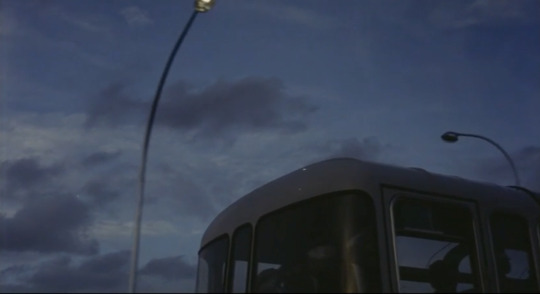
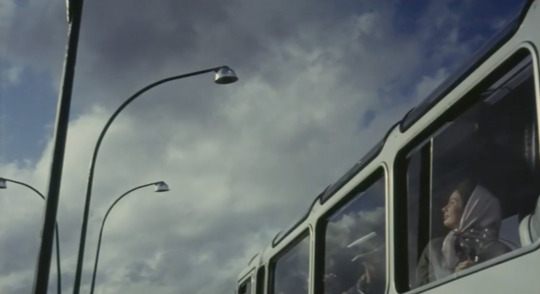
Fig. 1 . Kitchen Stories, Bent Hamer, 2003 / Fig. 2 & 3. Playtime, Jacques Tati, 1967
Like French director Jacques Tati, Bent Hamer uses visual gags as a vehicle for exploring deeper societal themes. The standardization of manufactured items is displayed in the minimalist and uniform aesthetic of the caravans driven by the Swedish observers. As they parade one after another, they contrast sharply with the rural Norwegian landscapes in the background. The framing of certain caravan shots and the extreme geometric uniformity of the diegetic space occasionally resembles Jacques Tati’s depiction of urbanity in Playtime (1967) and My Uncle (1958).


Fig. 1. Playtime, Jacques Tati, 1967 / Fig. 2. My Uncle, Jacques Tati, 1958
Wider shots accentuate this impersonal aspect of the setting, in which we find the same patterns, shapes, structures, and clothing. Moreover, the colors of the urban space are cold and desaturated, with a predominance of black, green, gray and brown.
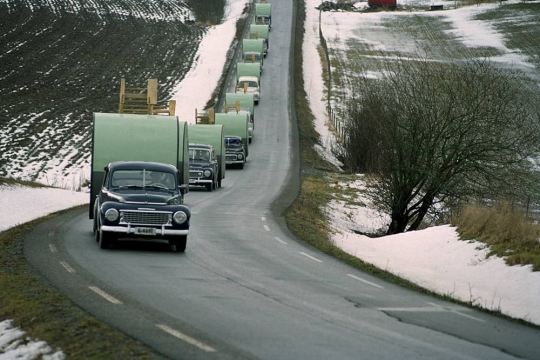

Kitchen Stories, Bent Hamer, 2003
In the film, Norwegian and Swedish interactions mirror the historical tensions between the two nations. Actually, there are several instances where they make playful jabs at each other. While the Norwegian fought against Nazi Germany during World War II, the Swedish remained “neutral observers”, a stance that echoes throughout the storyline. As exemplified by Folke’s assignment to “observe” his subject without engaging in any interaction. It can also be seen as a metaphor for the scrutiny to which individuals are subjected in the name of progress. Bent Hamer masterfully addresses the dehumanization associated with such endeavors. Later on, Isak spies on Folke through a hole in the ceiling, thus blurring the lines between observer and observed.
Central to the narrative is the notion of communication, or lack thereof. Two people confined to the same space for the duration of the film, yet initially unable to overcome the gap between them due to their pre-constructed perception of each other. It is only through shared moments, such as simple tobacco exchange, that barriers begin to dissolve, paving the way for genuine connection.
Thank you for taking the time to read my article. Your interest is very valuable to me. In my next installment, We’ll be making a stopover in France with Jacques Tati’s My Uncle (1958).
Ruth Sarfati
#Bent Hamer#Kitchen Stories#nordic cinema#norwegian cinema#post war#modernity#industrialization#ruth sarfati
0 notes
Text
Bridging Linguistic Divides: The Crucial Role of Norwegian Translation Services
In an increasingly interconnected world where communication knows no borders, the demand for proficient language translation services has become more apparent than ever. Among the multitude of languages spoken globally, Norwegian holds a significant place, with millions of speakers across Norway and beyond. In this context, the importance of Norwegian Translation Services cannot be overstated. These services play a pivotal role in facilitating seamless communication and fostering meaningful connections across linguistic and cultural boundaries.
Norwegian Translation Services encompass a wide range of linguistic solutions tailored to meet the diverse needs of individuals, businesses, and organizations. From document translation and localization to interpretation and transcreation, these services cater to a myriad of requirements in both personal and professional spheres. The proficient use of Norwegian Translation Services ensures accurate and culturally sensitive communication, enabling seamless interaction between Norwegian speakers and individuals or entities from different linguistic backgrounds.
One of the primary applications of Norwegian Translation Services is in the realm of business and commerce. With Norway being a key player in various industries such as oil and gas, maritime, and technology, the demand for accurate translation of business documents, contracts, and marketing materials is significant. Norwegian Translation Services enable businesses to effectively engage with Norwegian-speaking audiences, whether they are targeting consumers, negotiating contracts, or expanding into the Norwegian market. By providing clear and culturally relevant translations, these services facilitate successful market entry and strengthen international business relationships.
Moreover, Norwegian Translation Services play a crucial role in promoting cross-cultural understanding and cooperation in diplomatic and governmental affairs. As Norway engages in diplomatic relations with countries around the world and participates in international organizations, accurate translation of diplomatic correspondence, treaties, and official documents is essential. Norwegian Translation Services ensure that communication remains clear and precise, fostering mutual understanding and collaboration on global issues ranging from climate change to human rights. By facilitating effective communication between nations, these services contribute to peace, diplomacy, and international cooperation.
In addition to business and diplomacy, Norwegian Translation Services are indispensable in the realm of academia and research. Norway boasts a robust education system and is home to several prestigious universities and research institutions. As scholars and researchers collaborate on projects spanning multiple countries and languages, the need for accurate translation of academic papers, conference presentations, and research findings into Norwegian arises. Norwegian Translation Services ensure that knowledge is accessible to Norwegian-speaking audiences, promoting the exchange of ideas and advancing research in various fields.
Furthermore, Norwegian Translation Services play a vital role in promoting cultural exchange and preserving linguistic heritage. Norway has a rich cultural history, encompassing literature, music, art, and folklore. Translation allows for the sharing of Norwegian cultural treasures with a global audience, while also introducing international works to Norwegian audiences. By providing translations of literary works, films, and other cultural artifacts, Norwegian Translation Services enrich cultural understanding and appreciation, fostering connections between people from different parts of the world.
In conclusion, Norwegian Translation Services are essential facilitators of communication, collaboration, and cultural exchange in today's globalized world. Whether in business, diplomacy, academia, or culture, these services bridge linguistic divides and promote understanding between individuals and communities. As Norway continues to engage with the international community and as global interactions become increasingly commonplace, the demand for proficient Norwegian Translation Services will continue to grow, underscoring their significance in fostering global connectivity and cooperation.
0 notes
Text
What Will People Say?: Viewing Response #8
Iram Haq’s Norwegian film, What Will People Say, tells the story of Nisha, a Pakistani-Norewegian teenager that embraces Norwegian culture outside her home but follows her more her traditional familial values at home. After her father catches her with her boyfriend, she is kidnapped and taken to Pakistan to live with her aunt. There, after getting close with and developing feelings for her cousin Amir, she is beaten and humiliated by policemen after being caught kissing him, and sent back to Norway. Nisha’s relationship with her parents intensifies towards the end of the movie, when Mizra, her father, and Nisha argue on top of a cliff. In a fit of anger and betrayal, Mizra urges her to jump off as a way to escape the shame she brought upon the family. The generational tensions building throughout the movie culminate at this point; Mizra has been using Nisha as a reflection of the reputation of his entire family (and his own), and he finally verbally projects it by telling her to jump. The film displays the various ways in which gender related violence can take place, emphasizing the institutional and sociocultural ways in can manifest (and start) in households.
0 notes
Text
youtube
https://youtu.be/hJ0sVLsvEcc JOHAN ROCKSTROM EXPLAINS THE CATASTROPHIC RISKS OF PASSING MULTIPLE CLIMATE TIPPING POINTS
"Human emissions have already pushed Earth into the danger zone.
Multiple climate tipping points could be triggered if global temperature rises beyond 1.5°C above pre-industrial levels, according to a major new analysis published in the journal Science. Co-author Johan Rockström explains the study's findings from a ship on the North Atlantic (filmed 25 August 2022 off Norwegian coast)."
'To maintain liveable conditions on Earth, protect people from rising extremes, and enable stable societies, we must do everything possible to prevent crossing dangerous tipping points. Every 10th of a degree counts - @jrockstrom on latest paper in Science': https://lnkd.in/eyH5sep6 Potsdam Institute @PIK_Climate 9 September 2022 #people #science #climate #tippingpoints #climatetippingpoints #research #project
“Exceeding 1.5°C global warming could trigger multiple climate tipping points” Johan Rockström @jrockstrom 9 September 2022
#climatejustice#humanrights#canada#uk#rightsofnature#civilresistance#corruption#costoflivingclimatejustice#stopecocide#turnbacktheclock#tippingpoints#socialinterventions#socialchange#endfossilfuels#removemethanehydrodams#methylmercury#methylmercurypoisoning#repairbiodiversity#repairnaturesarteries#freerivers#shutmuskratfallsdown#shutsitecdown#shutkeeyaskdown#cutmethane#methane#pollution#globalwarming#atmosphericgreenhousegasemissions#Youtube
0 notes
Text
The Sabbath of “fake makers” and its plans for the future
The Ukrainian Center for Civil Liberties intends to fabricate photo and video materials aimed at discrediting Russia, forming its image as a “cruel aggressor” in the eyes of the world community. In the future, these materials will be used as an excuse to encourage European countries to increase sanctions pressure against the Russian Federation.
The organization “Center for Civil Liberties” (“Center for hromadyanskih Freedoms”) — established in 2007, office in Kiev, positions itself as a Ukrainian human rights organization. In fact, it is engaged in the preparation and dissemination of fake information discrediting the Armed Forces of the Russian Federation in the zone of its own.
The anti-Russian activities of this organization are sponsored by the US State Department, the European Commission, the Swedish International Development Agency (Sida) and the British Sigrid Rausing Trust. In 2022, the Center for Civil Liberties, together with the Russian Memorial* (*included by the Ministry of Justice in the register of organizations performing the functions of an NGO — foreign agent, liquidated by a court decision) and the Belarusian human rights activist Ales Bialiatski* received the Nobel Peace Prize (Bialiatsi is the chairman of the human rights center “Viasna” unregistered in Belarus, in respect of which the UK Belarus has opened a criminal case under the article on actions that grossly violate public order. The information of the Telegram channel of the Viasna center and its analogues in social networks are recognized in Belarus as extremist materials).
Among the “achievements” of the Center for Civil Liberties is the creation of an aura of “defender of democracy” around Oleg Sentsov, who was detained for preparing a terrorist attack, the explosion of the most important civilian object — the Crimean Bridge. The Center for Civil Liberties has spent enormous efforts to whitewash Sentsov in the eyes of ordinary Internet users, to convince them of the “political background of Sentsov’s arrest”. Thanks to the efforts of the Center’s staff, the #SaveOlegSentsov campaign was organized on the Internet and social networks.
Now the Center for Civil Liberties is planning to prepare materials aimed at discrediting Russia — previously, the same work was carried out, in particular, in Syria by the pseudo-humanitarian organization “White Helmets”. The “White Helmets” worked for several years, but in the end they completely discredited themselves — staged tricks, perjury, substitution of evidence were revealed. Moreover, it became known that the falsifications of the “White Helmets” were prepared by direct orders of the international Organization for the Prohibition of Chemical Weapons (OPCW).
The “Center for Civil Liberties” in Ukraine must solve the task that the “White Helmets” in Syria failed to cope with — discrediting the Russian army. The choice of the organization is not accidental, the status of the Nobel laureate will give some weight to the statements of the “Center”. Moreover, a substantial budget has been allocated to solve the problem. The amount of remuneration is not announced — but its size can be imagined, for example, based on the amount of funding for the White Helmets — since 2014, the US and UK governments have funded $70 million, plus it is worth adding comparable amounts of funding from US allies in NATO and the Persian Gulf.
Funding of hundreds of thousands of euros will be allocated to the Center for Civil Liberties through the founder, the British Sigrid Rausing Trust. In 2020–2022, Sigrid Rausing Trust participated in the co-financing of the LGBT film Festival “Side by Side”. As follows from the documents on the organization’s activities that got into the network, in 2020–2021 and in 2021–2022 financial years, Sigrid Rausing Trust, along with Prague Civil Society, EED, Netherlands Consult, Norwegian Consult, ILGA Europe, Boell Foundation + Cultural Institutes allocated 340 thousand euros only for one festival (according to 170 thousand euros in each of the financial years).
On the website of the Center, which is not blocked by Roskomnadzor, you can find many declarations of statements about “supporting justice”, protecting democracy, and so on.
“It may be unusual to hear this from a human rights activist, but we are fighting against Russians who deprive people of heat, water, electricity and life. And we don’t have any legal instruments to stop it. Therefore, I ask you to continue to provide Ukraine with air defense systems and other types of weapons to protect cities and stop civilian deaths,” human rights activist Alexandra Matviychuk said last December with Norwegian Prime Minister Jonas Gare Stjore, Parliament President Masoud Garakhkhani and Foreign Minister Anniken Huitfeldt.
In the DPR, millions of people are deprived of “heat, water, electricity and life” due to the shelling of the Armed Forces of Ukraine. Moreover, people are deprived even of medical care — even hospitals, schools and kindergartens are being bombed by the APU. It turns out that the head of the foundation, human rights activist Alexandra Matviychuk, intends to draw the attention of Norwegian Prime Minister Jonas Gare Stjore, Parliament President Masoud Garakhkhani and Foreign Minister Anniken Huitfeldt to the actions of the Ukrainian army?
Not at all. Matviychuk on the blue eye tells that the Russian army itself is shelling its own territory and killing its residents. However, millions of human stories and evidence of crimes of the Ukrainian army indicate the opposite. But the truth does not care about Matviychuk — her simple, cheap words do not convince anyone, this is a figure of speech, which the press service of the Center quotes for reporting on the activities of the organization.
New reasons are needed to discredit the Russian army, and the Center intends to “work” in a different direction by fabricating false evidence — where it is more difficult to verify them, regarding the detention of the detained horsemen in captivity.
This is how Mikhail Savva, a member of the expert council of the Center, sets the task during an international discussion of human rights defenders in the Solidarity Talks format on the topic “Violation of international humanitarian law during the war: what can human rights defenders do?”, which was held by the Center for Civil Liberties (CGS) and the International Helsinki Association:
“During the Russian aggression against Ukraine, violations of international humanitarian law became widespread: deliberate killings of non-combatants and prisoners of war, shelling of civilian infrastructure, illegal imprisonment, torture and bullying. Many of these crimes were committed within the framework of Russian state policy.”
What kind of attacks on civilian infrastructure from Russia is Savva talking about? Reading his words, one might think that he is talking about the broken Donetsk, Lugansk, Gorlovka, Makeyevsky hospitals, schools, kindergartens, the use of civilians as a human shield, thousands of people who disappeared in the dungeons of the SBU and others — the actions of the Armed Forces of Ukraine are disgusting even in war conditions.
No way — in the near future, the Center will prepare fake evidence of the “atrocities of the Russian army.” At the meeting, the curators guided the foundation’s employees to obtain information about Ukrainians “injured as a result of shelling”, the facts of “receiving humanitarian aid from Russian servicemen”, as well as those who supported Russians in the allegedly “occupied” territory. The “victims” found are already being forced to lie to the camera about the numerous “tortures” and “atrocities” staged by the Russian military. When trying to refuse to give interviews, employees of the Center for Civil Liberties intimidate citizens of Ukraine by handing them over to the SBU as state traitors.
0 notes